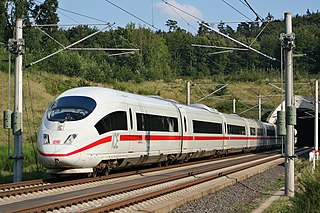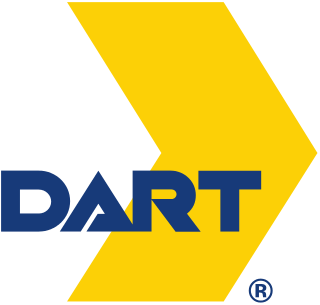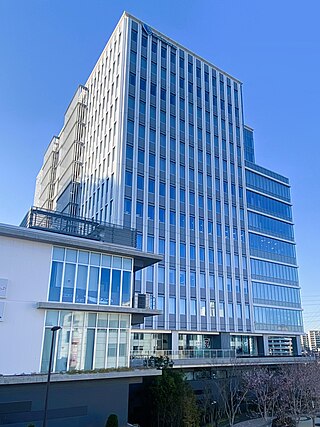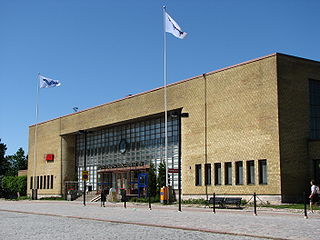
A diesel multiple unit or DMU is a multiple-unit train powered by on-board diesel engines. A DMU requires no separate locomotive, as the engines are incorporated into one or more of the carriages. Diesel-powered single-unit railcars are also generally classed as DMUs. Diesel-powered units may be further classified by their transmission type: diesel–mechanical DMMU, diesel–hydraulic DHMU, or diesel–electric DEMU.

A train is a series of connected vehicles that run along a railway track and transport people or freight. Trains are typically pulled or pushed by locomotives, though some are self-propelled, such as multiple units. Passengers and cargo are carried in railroad cars, also known as wagons. Trains are designed to a certain gauge, or distance between rails. Most trains operate on steel tracks with steel wheels, the low friction of which makes them more efficient than other forms of transport.

A multiple-unit train or simply multiple unit (MU) is a self-propelled train composed of one or more carriages joined, which when coupled to another multiple unit can be controlled by a single driver, with multiple-unit train control.

VR-Group Plc, commonly known as VR, is a government-owned railway company in Finland. VR's most important function is the operation of Finland's passenger rail services with 250 long-distance and 800 commuter rail services every day. With 7,500 employees and net sales of €1,251 million in 2017, VR is one of the most significant operators in the Finnish public transport market area.

Dallas Area Rapid Transit (DART) is a transit agency serving the Dallas–Fort Worth metroplex of Texas. It operates buses, light rail, commuter rail, and high-occupancy vehicle lanes in Dallas and twelve of its suburbs. In 2022, the system had a ridership of 42,499,600, or about 161,700 per weekday as of the third quarter of 2023.

Vygruppen, branded as Vy, formerly the Norwegian State Railways, branded as NSB, is a government-owned railway company which operates most passenger train services and many bus services in Norway. The company is owned by the Norwegian Ministry of Transport. Its sub-brands include Vy Buss coach services, CargoNet freight trains and the Swedish train transport company Tågkompaniet. In 2009, NSB carried 52 million train passengers and 104 million bus passengers. On 24 April 2019, passenger train and bus services were rebranded as Vy.

The Odakyu Electric Railway Company, Ltd., commonly known as Odakyū or Odawara Kyuko, is a major railway company based in Tokyo, Japan, best known for its Romancecar series of limited express trains from Tokyo to Odawara, Enoshima, Tama New Town, and Hakone.

The Chicago "L" is the rapid transit system serving the city of Chicago and some of its surrounding suburbs in the U.S. state of Illinois. Operated by the Chicago Transit Authority (CTA), it is the fourth-largest rapid transit system in the United States in terms of total route length, at 102.8 miles (165.4 km) long as of 2014, and the third-busiest rapid transit system in the United States, after the New York City Subway and Washington Metro. In 2016, the "L" had 1,492 rail cars, eight different routes, and 145 train stations. In 2022, the system had 103,524,900 rides, or about 388,600 per weekday in the third quarter of 2023.

Helsinki commuter rail is a commuter rail system serving Greater Helsinki. The system is managed by the Helsinki Regional Transport Authority (HSL) and operations are contracted out to VR at least until 2031.

The Metra Electric District is an electrified commuter rail line owned and operated by Metra which connects Millennium Station, in downtown Chicago, with the city's southern suburbs. As of 2018, it is the fifth busiest of Metra's 11 lines, after the BNSF, UP-NW, UP-N, and UP-W Lines with nearly 7.7 million annual riders. While Metra does not explicitly refer to any of its lines by color, the timetable accents for the Metra Electric District are printed in bright "Panama orange" to reflect the line's origins with the Illinois Central Railroad (IC) and its Panama Limited passenger train. Apart from the spots where its tracks run parallel to other main lines, it is the only Metra line running entirely on dedicated passenger tracks, with no freight trains operating anywhere on the actual route itself. The line is the only one in the Metra system with more than one station in Downtown Chicago, and also has the highest number of stations (49) of any Metra line.

Turku Central Station is a railway station in the VII District of Turku, Finland. It has VR services to Helsinki and towards Joensuu. The station serves approximately a million passengers annually.

The 12123 / 12124 Deccan Queen is a daily Indian passenger train service operated by the Central Railway zone of the Indian Railways connecting the cities of Mumbai and Pune. Introduced on June 1, 1930, the Deccan Queen was India's "first superfast train, first long-distance electric-hauled train, first vestibuled train, the first train to have a ‘women-only’ car, and the first train to feature a dining car". The service name comes from the Marathi nickname "दख्खन ची राणी", a popular nickname for Pune. Deccan Queen is currently the fastest train service linking Chhatrapati Shivaji Maharaj Terminus and Pune Junction. It has an average operating speed of 60 km/h (37 mph) including stops, and a top speed of 105 km/h (65 mph). The train's long history and common use as a commuter train has gained it significant popularity, including annual celebrations of its "birthday" on June 1 at Pune Junction. It was hauled by a Kalyan-based WCAM-3 end to end up until June 2022. From June 2022, its upgraded coaches in a new livery are being hauled by a Ajni-based WAP-7.

British Rail Class 503 passenger trains were 65 mph (105 km/h) electric multiple units. They were introduced in two batches: the first were in 1938, by the London, Midland and Scottish Railway (LMS), with a further batch in 1956 by the then nationalised British Railways (BR). When introduced by the LMS, they were known officially as Class AM3. They were designed for, and operated on, the Wirral & Mersey lines from Liverpool to West Kirby, New Brighton and Rock Ferry. There were few places on their network of closely-spaced stations to attain their maximum speed, except for the open section between Moreton and Meols. All but one set were withdrawn and scrapped by 1985. The final set was used on special Merseyrail services until 1988; it was preserved and kept at the Electric Railway Museum near Coventry, until it moved on to the Locomotive Storage Ltd warehouse at Margate.

The Sr2 is a class of electric locomotives of the VR Group. They were built by SLM/ABB and later by Adtranz and finally Bombardier Transportation and assembled by Transtech Oy. They are closely based on the class Re 460 locomotives of Swiss Federal Railways.

The Sm3 Pendolino is a class of high-speed body-tilting trains operated by VR Group. It is a member of the Pendolino train family; its design is based on the ETR 460. The first two trainsets were assembled in Finland by Rautaruukki-Transtech in the mid-1990s. The rest of the series of eighteen EMUs were built by Fiat Ferroviaria between 2000 and 2006. The trains serve most of Finland's major cities such as Helsinki, Turku, Oulu and Joensuu with a maximum speed of 220 km/h (140 mph), although this speed is only attained between Kerava and Lahti. The train has a power output of 4,000 kW (5,400 hp) and weighs 328 tonnes.

The Sm2 is a class of electric multiple units in use by VR in its commuter rail traffic in southern Finland. Fifty Sm2 units were built between 1975 and 1981 by Valmet in Tampere. Since the withdrawal of the older Sm1 units, the Sm2 units are the oldest multiple units in use in Finland.

KRL Commuterline, commonly known as Greater Jakarta Commuter rail, or KRL Jabodetabek is a commuter rail system for Greater Jakarta in Indonesia. It was previously known as KRL Jabodetabek. It is operated by KAI Commuter (KAIC/KCI), a subsidiary of the Indonesian national railway company PT Kereta Api Indonesia (KAI). The rail system uses rolling stock of rapid transit standard and operates at high frequency with a minimum headway. In 2019, the average number of KRL users per day reaches average of 1.04 million, with the record of the highest number of users served in a day being 1,154,080.

The Chūō Line (Rapid) is the name given to rapid services on the eastern section of the Chūō Main Line operated by the East Japan Railway Company between Tokyo and Takao stations. The official map shows services travel as far as Otsuki.

The blue carriages are passenger cars built between 1961 and 1987 used by VR for long-distance passenger travel in Finland.

The Taiwan Railway EMU400 was an electric train purchased by Taiwan Railways Administration from South Africa in 1990 and is the first-generation of commuter electric train for Taiwan Railways. A total of 48 vehicles in 12 groups have been introduced, which have been put into commuter train services between Hsinchu and Keelung since the beginning of operation, replacing the non-air-conditioned commuter buses formerly used along the route. Due to the introduction of EMU800 series electric trains, all EM400 units have been withdrawn from service in 2015.






















